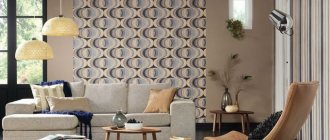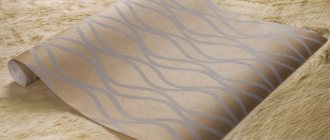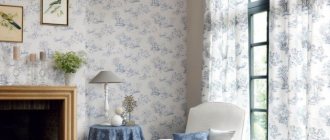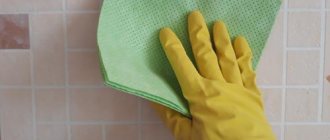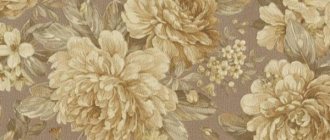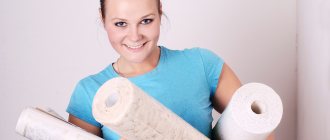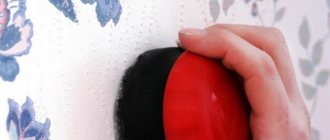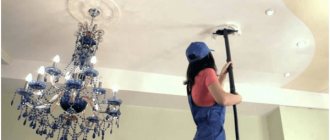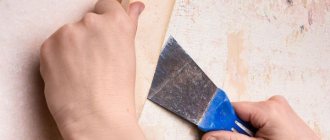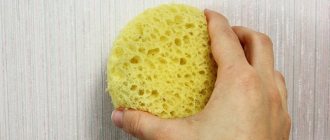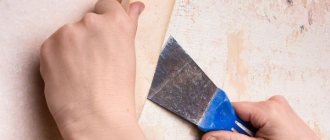A huge advantage of non-woven fabrics is that they can be cleaned of dirt, but it is important to know how to do it correctly. Among the types of wallpaper, non-woven ones are the most preferable. But if the wallpaper has a paper base, then non-woven fabrics can be washed; more precisely, they need to be wiped only with a slightly damp cloth.
If the canvas has a rough pattern, you can remove the dust with a vacuum cleaner. More often, vinyl and non-woven types of wallpaper have a textured pattern.
Non-woven wallpaper: what is it?
Structural non-woven wallpaper is made from an analogue of cellulose, a material very similar to paper. Industry adds various substances to this material, after which the modified fiber acquires new qualities, including environmental friendliness.
Unlike paper wallpaper, embossed non-woven wallpaper is made using a different method - hot stamping. This method is labor-intensive, but the complexity of the production process is easily compensated by the strength and durability of the resulting product. In some cases, they are even called anti-vandal hot stamping wallpaper.
Methods for cleaning glue stains
You can remove glue stains using an anti-glue product.
When working with an adhesive composition whose manufacturer has not stated that the product does not leave stains, you should remember that it is very difficult to remove glue from wallpaper after it has hardened. When such a substance dries, it does not wipe off, but remains, and after a while it may turn yellow or become moldy. Even a stain of paste, the most primitive means for gluing wallpaper, is very difficult to wipe off after hardening. The glue, cellulose or made from polyvinyl acetate, cannot be removed because after the polymerization process it does not dissolve in either water or alcohol. If you try to soak the stain so that it swells, you can ruin the whole job.
Related article: Curtains with hinges: how to sew them yourself
You can test the effect of a chemical substance in an inconspicuous place. It is suitable for removing instant glue, PVA, polyurethane-based contact adhesives, as well as label marks, ink and marker stains. This chemical may dissolve the surface when applied
Therefore, when using it, you need to be careful and test it before using it. The instructions tell you how to remove frozen drops of adhesive from the surface.
It is applied to the contaminated area and left for 60 minutes. After waiting the required time, wipe the treated area with a dry cloth and wash in soapy water.
If this remedy does not help, then all that remains is to put up with the stains or disguise them. Hang a decorative plate or some object in this place and cover it with furniture. If this option does not suit you, then the wallpaper should be re-glued.
Characteristics, types and composition
Depending on the key characteristics and main purpose, the following types of non-woven wallpaper are distinguished:
- Wallpaper made entirely of non-woven fabric. The composition of non-woven wallpaper is almost completely devoid of cellulose, sometimes it is present in very minimal quantities. This material is the most common on the market.
- Wallpaper, the reverse side of which is made of non-woven fabric. The outer material can vary, but most often it is vinyl. It is quite resistant to any type of impact, but still such hot-stamped wallpaper is not recommended for use in the hallway or kitchen, given its disadvantages. The combination of a practical and easy-to-stick non-woven side and a practical vinyl side makes this type of wallpaper one of the most popular. You can also find paper wallpaper on a non-woven basis on sale.
- Paintable wallpaper made entirely of non-woven fabric. Multiple color changes while fully maintaining decorative qualities. An important advantage is the low price. White non-woven wallpaper is designed for those who like to change their environment often. Painting wallpaper is a wonderful way to change the interior.
To avoid being deceived by the seller and not to buy paper wallpaper at the price of non-woven wallpaper, you need to make a small tear along the edge. Paper wallpaper with a non-woven backing will have unevenness.
Color palette and combinations
Plain non-woven wallpapers are most often presented in not the brightest colors, although, of course, they can also be found in a palette of shades. This is explained by the fact that the structure of such materials is already expressive in itself, so a bright color, for example, green, is often unnecessary. If an exceptionally bright color is needed to implement a design idea, it is better to paint non-woven wallpaper.
Non-woven wallpaper in the interior can be very extravagant. If the wallpaper is green or a different color produced in Europe, for example, by emotional Italians, then in the palette of wallpaper for the ceiling for painting you can find a variety of color textures and patterns. Attention to detail is typical of Russian manufacturers. Their products meet design requirements, are easy to apply and last a long time.
As for fashion and design, deep colors and black and white shades are popular in the latest season, which can be used in any room when decorating all types of premises. Non-woven wallpaper with a pattern is not only beautiful, but also modern.
Advantages and disadvantages
Such wallpaper is relatively new on the market, but this time was enough to appreciate all the advantages of non-woven wallpaper:
- maintaining dimensions after drying;
- increased density of the canvas, allowing you to hide cracks and unevenness on the wall;
- resistance to fire, smoldering and high temperatures;
- oxygen transmission;
- water resistance;
- maintainability;
- possibility of painting.
Separately, it should be noted such features of non-woven wallpaper as ease of gluing and leveling. When using non-woven wallpaper, glue must be applied only to the wall. This helps preserve the quality of the flooring, time and effort spent on repairs. Wallpaper can also be removed easily. Before removing non-woven wallpaper, you do not need to carry out any preparatory measures.
Non-woven wallpaper also has disadvantages:
- low resistance to dirt due to the porous structure and ability to collect dust;
- high cost relative to other types of wallpaper.
It is worth noting that these disadvantages are very insignificant relative to the advantages, which makes any non-woven wallpaper the most popular material for interior decoration. And if you know how to glue meter-long non-woven wallpaper, then soon the room will sparkle with new colors.
Photo gallery
We present to your attention 28 more photos of design ideas for non-woven wallpaper in the interior of an apartment. Enjoy watching!
Non-woven backing for wallpaper
In addition to decorative material, substrates are made from non-woven fabric. Intended for wallpaper stickers, they have the following purpose:
- sound and heat insulation;
- leveling the wall;
- extending the service life of wallpaper;
- improving the environmental characteristics of the material;
- increasing the strength of wall coverings.
A non-woven backing can replace a layer of putty, reinforcing microscopic cracks, hiding the disadvantages of the wall and leveling its surface. A high degree of elasticity, density and integrity make it possible to strengthen the sound insulation and noise insulation system of the room and extend the service life of the wallpaper.
The non-woven gray backing is very resistant to water and moisture. At the same time, it is vapor permeable. When the humidity in the room fluctuates, wallpaper glued to such a substrate retains its original dimensions. Continuous air exchange prevents mold from forming on the wall surface. And of course, such a base for wallpaper adheres perfectly to a wall that has been previously coated with adhesive.
After gluing the non-woven backing, you need to let it dry. This process will take about a day. Only after this can you start gluing gray or colored wallpaper. Beige non-woven wallpaper on a backing will not show through, the result will be magnificent.
Darkening and yellowing of wallpaper
Yellow spots on the wallpaper are visible. There are several types of stains on the wallpaper, as well as their causes.
The first problem is that dark spots, sometimes even black, appeared on the wallpaper. The reason for this phenomenon may be mold or mildew that remains on the wall. To avoid this defect, the surface must be prepared more carefully. Mold is removed first using a physical method, then treated with an antiseptic. A more mysterious, but still quite common problem is yellow spots on the wallpaper. There may be several reasons for yellowing:
- poor quality glue;
- remains of drying oil on the walls;
- incorrectly selected primer;
- contact of wallpaper with any substance while applying glue to it;
- contact of wallpaper with an iron object (for example, reinforcement in a concrete slab).
Sometimes the yellowing disappears after it dries completely. But if this does not happen, then one or more of the above reasons occurs.
We offer our services for preparing walls for wallpapering. Daily visit of masters. No prepayment. Prices: - removal of old wallpaper 70 rubles/sq.m. m - plaster 500 rub/sq. m - putty 400 rub/sq. m - polishing 150 rub/sq. m - primer 50 rub/sq. m You can view the prices for all our services in the “Price” section.
or click to call: +7(917)-571-01-57
Is it possible to wash non-woven wallpaper?
As already mentioned, one of the obvious advantages of non-woven wallpaper is its resistance to moisture, so they can certainly be washed, while following certain rules. Before removing non-woven wallpaper that is heavily soiled, you can try washing it. Before cleaning, pay attention to the markings.
If non-woven wallpaper for the living room was purchased a long time ago and the label has not been preserved, you should try to wash the wallpaper in an area that is not in the direct line of sight. Before washing off the dirt, a piece of washable wallpaper needs to be wetted and allowed to dry. If after drying there are no changes in the structure of the material and the color scheme of the pattern, then the hot-stamped wallpaper can be wetted. Then you need to carry out similar actions using different types of detergents. Wash off the dirt thoroughly but gently.
The question of how to clean washable non-woven wallpaper is also relevant. Choosing a detergent is a responsible matter. It should be noted that choosing the right product is very easy, because non-woven wallpaper for the hall is quite durable and resistant to external influences. Such well-known solutions as a mixture of laundry or toilet soap with water, dishwashing liquid or a solution of soda and water are not only perfect for washing, but will also cope with the task at hand.
If you managed to save the wallpaper label, then you need to pay attention to the marking. So, if one wave is depicted, then they can be wiped with a damp cloth. Using too much moisture will ruin plain wallpaper. Water can be used if the list of markers shows two or three waves. If you find a ridge pattern on the label, non-woven wallpaper can be cleaned with a soft brush, because it is washable.
After washing non-woven wallpaper, you must wipe it thoroughly with a dry cloth. The more the material absorbs, the better. Under no circumstances should you use a hairdryer to dry glued wallpaper; this can ruin it, exacerbating the imperfections of the coating.
What are the features of wallpaper from different countries - manufacturers?
Among the variety of non-woven wallpapers, you need to navigate the manufacturers. Different manufacturing countries have their own characteristics:
- Germany. Leader in the production of high-quality non-woven wallpaper. German manufacturers often invite the most famous designers to collaborate. The products of these factories are of exceptional quality.
- Italy. Italian factories are more inclined towards design than quality. Their products are not as high quality as German ones, but they also maintain high levels of performance. It is not uncommon for designers with names all over the world to be invited. Several collections are released throughout the year.
- Belgium. Quality and good design at low prices. Many Russian designers turn their attention specifically to Belgian factories.
- Sweden. Laconicism, airiness, simplicity and environmental friendliness characterize non-woven wallpaper from Swedish factories.
- Russia. High quality is ensured by German equipment from Russian factories. Varied designs attract attention. The low price is a distinctive point in comparison with foreign analogues.
The conclusion suggests itself. You can purchase quality at affordable prices from Russian companies. German wallpaper will be much more expensive than all others, but for this money you can buy the highest quality and luxurious appearance.
Wallpaper or wall painting – what to choose?
What you need to know when choosing wallpaper
How to wash paper wallpaper from dirt
Paper cannot be washed, it will quickly become unusable, so paper wallpaper can only be wiped with a damp cloth, without applying too much pressure on the material. If wet cleaning does not remove dirt from them, it is better to replace the coating with a new one. There is no other way, because once upon a time when finishing you chose the cheapest option.
The so-called textile wallpaper is usually classified as this type. It is better to clean them with a regular vacuum cleaner.
The only exception is paper wallpaper with a special moisture-resistant coating. But even with moisture resistance, you should be wary of wet tears. Be careful. Washing paper wallpaper should be done carefully.
How to clean wallpaper using bread
The method that our great-grandmothers successfully used is suitable, first of all, for delicate paper wallpaper.
- Press a piece of fresh pulp onto the stain and hold for several minutes. Gluten will absorb dirt. Repeat the procedure until the problem area brightens.
- Another option is to use stale wheat bread. Use it to wipe the stain from top to bottom.
Washing technology
Plain wallpaper can be washed by sprinkling it with water and wiping it with a cloth.
Non-woven wallpaper is divided into several types: plain, patterned, painted. Therefore, the washing rules will also be different.
You can wash plain wallpaper with a soft cloth soaked in soapy water. The coating should be sprayed with water, dust collected with a rag and wiped with a dry cloth.
Non-woven fabric with embossing and patterns can be washed as follows:
- Use a vacuum cleaner to remove dust from the coating.
- Add a few drops of dishwashing detergent or washing powder to the water.
- Wipe the canvas with a soft sponge dipped in soapy water so that no streaks remain.
- Use a dry cloth to remove moisture.
Old trim should be vacuumed at low power to prevent the sheets from peeling off.
You can wash wallpaper for painting in the same way as a surface with a pattern. If water-based paint was used, they should be cleaned with a cloth slightly moistened with water. It will remove dirt without damaging the color layer. If the canvases are painted with acrylic or latex, they should be washed with water and detergents that do not contain abrasives.
Non-woven wallpaper dries quickly. In most cases, 1 hour is enough for this. Do not allow drafts during wet cleaning or when drying canvases. They can cause the coating to peel off. Also, you should not speed up drying using artificial heat, which can cause the wallpaper paste to dry out and the interlining to fall off.
Fabrics that easily tolerate moisture can be cleaned with a steam cleaner.
How to remove dirt from wallpaper using detergents
Washing the wallpaper is the easiest option to get rid of dirt. There is one minus - this method is contraindicated for paper coverings. But owners of non-woven and vinyl wallpaper can easily wash their wall coverings using water and various detergents.
- Before you start washing the wallpaper, you need to clean it with a dry soft brush. If this is not done, the dust will leave dirty streaks on the surface.
- Non-woven wallpaper can be cleaned of dirt with a sponge slightly moistened with warm water. Vinyl can be washed using foaming agents.
If the dirt is not removed the first time, the wallpaper should be dried. Only after this can the processing be repeated.
- Almost any stain can be cleaned by adding a little oxygen or chlorine bleach to the water.
- Wallpaper should be washed quickly so that it does not become soggy from water.
After washing, the wallpaper should be carefully blotted with a soft cotton cloth to remove any remaining moisture. Remember that excess moisture can ruin any vinyl covering, including washable ones.
If the wallpaper gets too wet, this problem can be eliminated with a pack of paper napkins or a roll of toilet paper. Just apply them to the problem area.
How to clean non-woven wallpaper
Non-woven wallpaper can be washed with any cleaning products. This could be dishwashing detergent, washing powder, liquid soap. LOC , which is produced by Amway, will help clean canvases from dirt and dust Will remove the fungus Whiteness or Anti-mold . HG will cope well with heavy stains .
Washing vinyl wallpaper should begin after determining the type of finish. If it is compact vinyl, you can clean them with soapy foam and a brush. It is better to rub the surface in a circular motion without pressing. If the vinyl is foam backed, only wash it with a soft cloth or sponge dampened with an all-purpose cleaner.
The surface of non-woven rolls is water-repellent, so it can be wet. After wet cleaning, wipe the canvas with a dry soft cloth.
How to clean wallpaper using an eraser or melamine sponge
A regular stationery eraser is suitable for processing paper, non-woven or vinyl wallpaper.
Hand stains can be easily rubbed with an eraser.
If you put an eraser in a container of kerosene overnight, it will remove traces of pens and wax crayons.
A modern replacement for an eraser is a melamine sponge. Important! Melamine sponge is an abrasive material. It will perfectly clean vinyl wallpaper, but can damage the pattern on non-woven wallpaper. First you should test it on a small area.
Traditional methods for eliminating pollution
Use the available products to help wash off dust, remove grease and other stains from wallpaper at home.
Cleaning from dirt
You can wash the wallpaper with soapy water. To do this, add grated laundry soap or a few drops of detergent to the water. Use a soft sponge soaked in the mixture to rinse the contaminated surface and wipe with a slightly damp cloth.
Fat removal
There are several ways to remove oil deposits from the coating:
- Lemon acid . Add 75 g of acid to 250 ml of warm water. Use a soft sponge soaked in the resulting product to treat the stain. After 5 minutes, rub, then rinse with a wet cloth.
- Dish gel . Add a couple of drops of dishwashing detergent to a liter of water. Clean the stain with soapy water and leave for 5-10 minutes. Wipe off with a damp sponge.
- Bread . To remove fat, you can treat the dirty area with bread crumb.
- Soda . A solution of this powder will clean any residue from wallpaper in the kitchen. Dilute 20 g of soda in a liter of water. Rinse the fabric.
- Talc . Fat can be removed with baby talcum powder. Apply the product to the stain for 10 minutes, then wipe with a sponge.
Pen marks
You need to wash the ink with a solution of 70% acetic acid and potassium permanganate. Apply the product onto the canvas with point movements and leave for 15 minutes. Remove the pink stain that formed at the site of the pen marks with a cotton swab soaked in peroxide.
You can remove ink in this way: moisten a sponge with alcohol and rub the stain until it disappears.
Cleaning and washing products
In cases where you know exactly the cause of contamination, folk methods can be more effective than store-bought remedies:
- Baking soda. Removes greasy stains, suitable for all types of washable wallpaper. Proportions - 2 tbsp. spoons per 1 liter of water.
- Baby powder. Copes with fresh grease stains. Sprinkle the desired area and leave for half an hour - the powder will absorb all the grease and you can remove it with a dry cloth.
- Soap solution. Removes fresh traces of felt-tip pens, pens and pencils. Proportions: 100 ml of liquid soap per 1 liter of water.
- Lemon acid. It will help you get rid of drawings made with alcohol markers and greasy deposits. Proportions - 2-3 spoons per 1 glass of water.
- Alcohol. Effective against old stubborn grease stains, marks from stickers and tape.
- Hydrogen peroxide. Cleans wallpaper from blood stains.
- Hydrochloric acid. Removes traces of brilliant green from the surface.
- Stationery eraser. Removes greasy deposits and fingerprints.
- Vinegar. Effective against glue residues. Use a 9% solution.
- Iron. Removes fresh greasy stains. You only need to iron the wallpaper through a sheet of paper.
After cleaning with any of the products described above, be sure to rinse the area with water.
There are no special wallpaper cleaning products, but there are universal compositions that can be used:
- HG is a phosphate-free cleaner for cleaning plastic, window sills, MDF (medium density fiberboard), and washable wallpaper. Removes stubborn dirt, nicotine stains, and does not discolor the surface.
- Pronto - removes fresh grease stains, light dirt, fingerprints.
- Freshbubble - liquid soap, kitchen spray or floor cleaning gel. Copes with greasy stains and plaque.
- Vanish is a carpet cleaner with rich foam. Suitable for cleaning any dirt.
Can non-woven wallpaper be washed?
Is it allowed to wash non-woven wallpaper? This question arises for everyone who has just decided to use this finishing material. It’s worth pointing out right away that non-woven wallpaper can be washed, which cannot be said about paper sheets, from which light stains can be removed only with a dry cloth and an eraser. Non-woven wallpaper can not only be washed, but also vacuumed, removing accumulated dust.
Various cleaning compounds can be used for washing. However, they must be non-specialized. These are ordinary products that you use every day. Non-woven wallpaper has a water-repellent surface, that is, it is not afraid of moisture. Feel free to start cleaning after you have stocked up with the necessary equipment. Upon completion of washing, wipe the surface with a soft cloth.
Household chemicals can be used to wash wallpaper
The drying time of the finishing material depends on the area that has been wet cleaned. Since the surface of the wallpaper is water-repellent, water does not penetrate deeper than the decorative layer. The linens dry very quickly; no sooner have you started washing them than they are already dry. For this, no more than 1 hour is enough. To remove dust from the surface of non-woven wallpaper, you can use regular napkins.
Non-woven wallpaper for applying paint is the most practical option. The type of cleaning agent depends on the quality of the paint used to finish the surface.
If you used water-based paint for painting, then the best option for cleaning the wallpaper would be a regular napkin slightly moistened with water. It will allow you to quickly remove stains without damaging the outer layer. If the canvases are coated with a water-dispersed, latex or acrylic paint composition, then the wallpaper can be washed with ordinary warm water using non-abrasive detergents.
Using paintable wallpaper in the living room
The presented recommendations allowed you to understand that it is possible to wash non-woven wallpaper. But for this you need to follow a number of simple but important rules. All work must be done carefully. Make sure that the surface is not damaged. In addition, it is important to take into account the type of canvas used - painted, vinyl on a non-woven basis, for painting.
General recommendations and advice
Basic recommendations:
- It is not recommended to heavily wet the surfaces with liquid.
- There is no need to rub the wallpaper too much; you need to blot it carefully so as not to damage the design and soak the paper.
- If the wallpaper is multi-colored, do not use strong chemicals or bleaches, so as not to wash off the pattern and avoid stains, use only dry cleaning.
- Stains should be removed immediately after contamination. If dirt gets on the wallpaper, you need to get rid of it immediately by blotting it with a clean cloth.
- Carefully remove dirt from paper wallpaper.
- It will be much more difficult to remove stubborn dirt from the surface.
Thus, to prolong the life of washable wallpaper, it is necessary to monitor its cleanliness and remove dirt in a timely manner. It is also necessary to choose the right wallpaper suitable for a specific room (find out how to choose the right wallpaper for the bedroom and kitchen).
Positive and negative qualities
Most often, non-woven wallpaper for painting is used for interior decoration. They have a textured surface that resembles decorative plaster or creates a certain ornament. They are allowed to be repainted more than once, and each time you will update and modify your interior without spending a lot of money. The best option would be to use types of paint such as acrylic, water-based and water-dispersed.
Washable wallpaper in a nursery is a great option
The following advantages of the finishing material are highlighted:
- The gluing process is much simpler than when using paper sheets. The glue must be distributed only on the wall. Non-woven wallpaper does not need to be treated with adhesive.
- The finishing process takes little time.
- If the surface of the walls was poorly prepared, but the glue was applied according to all the rules and instructions, then the initial strength of the canvases on a non-woven basis is higher than on paper.
- Non-woven washable wallpaper can be used for gluing surfaces that have minor defects.
Washable non-woven wallpaper is not without negative characteristics. These include:
- Despite the fact that the canvases are very dense, without preliminary impregnation with glue they are not plastic and will not stretch. Therefore, it is not worth covering large defects on the wall with them. The finishing material will not stick tightly to the wall and will need to be cut.
- Non-woven fabric is a material that transmits light. Therefore, you can glue this washable wallpaper only on a surface with a neutral color. The best option would be white walls, otherwise the previous pattern will show through.
Despite the disadvantages presented, washable non-woven wallpaper is much stronger than paper wallpaper. An important fact is that during the production of the material two bases are used: paper and non-woven fabric.
Why might glue stains appear on wallpaper?
Glue stains are easily removed using folk remedies - vinegar or vodka.
Stains may appear if the wall was not properly prepared for work. The wall must be cleaned of all remnants of glue remaining from the removed wallpaper. If the wall is made of plasterboard, it must be puttied. A surface that has lime stains on it needs putty. They can interact with wallpaper paste and appear as yellow spots that will be impossible to remove.
The wall, ready for work, must be perfectly clean, coated with an antifungal primer, and puttied. You cannot glue wallpaper on a wall that is not dry. This can also cause stains, which are attributed to poor-quality adhesive. Sometimes stains are caused by a chemical reaction between the old substance and the primer and the new adhesive. To prevent this from happening, the walls must be washed very carefully from old wallpaper.
When using a high-quality product, stains from excess glue that was not removed in time may also remain if a large amount was applied during the work.
Scheme for correct application of glue to wallpaper: 1. Spreading the canvas with paste. 2. Fold the canvas in half.
When working with non-woven wallpaper, you do not need to apply glue to it. They only treat the wall, and this is enough for the panels to attach well to the wall. When the wall is treated evenly, excess glue is removed with a wet, clean rag.
Surpluses appear only when there is an excess. Sometimes the wallpaper doesn't stick well, and then they start adding too much glue. But the reason may not be the glue at all, but a violation of the technology for diluting it. It must be prepared strictly according to the instructions, in water at room temperature, avoiding the formation of lumps.
When applying the adhesive solution, it is most convenient to use a wide natural bristle brush. Then the solution will lie evenly, and there will not be too much of it.
If you start working with paper wallpaper, then when distributing the adhesive onto the cut pieces you should be extremely careful and not allow it to get on the front side. And if this does happen, the glue is immediately removed with a clean, damp cloth.
If too much of this substance gets on the front part, then it is better not to use the damaged sheet than to worry about the stain appearing on the wall later.
Renovation, despite the labor intensity, is not a rare occurrence in an apartment, because you want to periodically update your home, breathe into it, if not new life, then at least new wallpaper. But often the installation of such a decorative coating ends with the appearance of unsightly stains from diluted glue on the surface of freshly glued walls. And no one is immune from this kind of oversight. Such stains are especially visible on dark plain canvases, and they spoil the entire impression, and at the same time the mood of the apartment’s inhabitants. And the question arises, how to remove glue from wallpaper after gluing. Let's first look at the reason for the appearance of these spots.
Pros and cons of the material
Non-woven wallpaper is intended for wall decoration. Consist of non-woven backing and foam vinyl. Non-woven fabrics have a thin paper base, which is covered with a layer of PVC film on top. The finishing material contained in compact vinyl film is not afraid of moisture and cleaning devices, be it a hard brush or a damp sponge. Foamed vinyl film is resistant to cleaning with a damp cloth soaked in a solution of detergents.
Among the advantages of the material the following are noted:
- recognized as environmentally friendly;
- it has high elasticity and strength;
- has the ability to hide wall defects;
- can be painted;
- affordable price;
- practicality in operation.
Among the shortcomings are noted:
- the high cost of some wallpaper modifications;
- non-woven fabrics without additional composition are very thin, and therefore with the slightest defect they become unusable;
- a thin canvas can show through the previous paint color.
Assessing the scale of distribution
The first signs of mold are not always noticeable. It can be localized under wallpaper, in hard-to-reach places, behind furniture or under baseboards. If the room is poorly ventilated, there is high humidity and water appears on the window frames, then you need to inspect the apartment daily. But if infection has already occurred, then first of all you need to assess the extent of the spread of mold.
If you see black spots in the corner of the room, you need to peel off the wallpaper a little to check for infection underneath. If the plaster is loose and there are visible signs of damage, the necessary actions should be immediately taken to eliminate the source of infection. Minor cosmetic repairs should be made to the room.
Spread of mold
If the walls in the bathroom are affected by fungus, you should immediately remove it so that it does not spread throughout the apartment. In the kitchen, moldiness occurs less frequently. But an inspection of the premises still needs to be done in order to eliminate possible consequences if the fact of the appearance of mold is ignored.
Once the causes of the wallpaper bloom, the extent of the infection and the damage caused have been clarified, we can begin to eliminate it.
How to wash non-woven trim?
If you decide to use thin fabrics, it is highly recommended to wash them with a damp cloth. In other cases, only dry cleaning is possible. Vinyl non-woven wallpaper is subject to wet surface cleaning depending on the degree of moisture permeability. Vinyl textiles cannot be washed.
As a solution for washing this type of wallpaper, you can use any cleaning products for plumbing, as well as dishwashing detergent. Non-woven fabrics have a water-repellent property, which allows for complete cleaning with a cleaning solution until contaminated areas are completely eliminated.
Tip: Surface drying time may vary depending on the area to be cleaned.
If there is a question about removing dust from the wallpaper, use a damp cloth. Non-woven wallpaper for painting is the most practical, and how best to wash it will depend on the material of the canvas being coated. If water-based paint was used, the canvas can be wiped with a damp cloth so as not to blur the design. If a water-dispersed, latex or acrylic emulsion was used, the material can be washed with warm water and non-abrasive cleaning powders.
How to clean wallpaper using various powders
Soda, starch, baby powder, talc are ready to become good helpers in the fight against greasy stains or traces of plasticine.
- For non-woven wallpaper, a mixture of water and starch (or soda) is suitable. The technology is simple: apply the paste to the stain and let it dry. Carefully remove the residue with a soft brush and wash the wallpaper with warm water.
- Paper wallpaper should not be wetted with water. It is better to treat the stain with any dry powder and leave it for a while. Remove any remaining powder with a cloth.
Types of stains and their removal
If there are grease stains on the wallpaper, you can remove them with talc. It is diluted with water and applied to the stain with a brush. The second option for cleaning various wallpaper stains is to remove them with an iron. To do this, cover the contaminated area with a paper napkin and heat it with an iron. It is recommended to repeat the procedure several times, changing the napkin for a new one. As a result, the stain transfers to the napkin. The remaining contamination is removed with a detergent composition.
If the stain is on vinyl wallpaper, remove it with dishwashing detergent. If the canvas has been stained with colored pencils, you can remove traces of them with a soft eraser.
Drawings made with a felt-tip pen are difficult to remove; they cannot be removed from paper or silk wallpaper. You can try to remove the felt-tip pen from non-woven wallpaper using water and laundry soap. Alcohol-based markers can be removed with diluted alcohol or citric acid.
Among the common stains remaining on wallpaper are fingerprints from dirty hands. In this case, it is recommended to wash paper wallpaper with improvised means, for example, soaked bread or a stationery eraser. Textured canvases should be washed without pressure and a large amount of liquid; in the worst case, they will crumple and move away from the wall.
Advice: It is important to eliminate more serious contaminants immediately after they appear.
If there are dirty places on the surface of the non-woven finish, they are cleaned by lightly shaking them off with a wet sponge. It is not recommended to smear the cleaner all over the stain.
General recommendations
If you have simple thin wallpaper in your kitchen, you need to carefully remove dirt from it.
- It is not recommended to generously wet the walls with solutions.
- You should not rub the surfaces to be treated too much; you should blot them carefully so as not to damage the design by soaking the paper.
- If there are many different colors on the wallpaper, it is contraindicated to use strong chemical compounds or bleaches to avoid washing off the image and causing stains. When cleaning such surfaces, only dry cleaning is used.
A competent approach and careful attitude to decorative finishing materials will provide them with an aesthetic appearance for a long time. If unwanted stains appear on the walls, you should try to immediately get rid of them using proven means at hand. If dirt becomes embedded in the surface, it will be much more difficult to remove in the future.
How to wash washable wallpaper (video)
Washable wallpaper gains its popularity because of its practicality; they come in different types and on different bases. They are perfect for the kitchen and can replace tiles, but not all washable wallpapers can be washed. In this article you will find useful and practically significant information on how to properly clean wallpaper from stains and wash it without much effort using available products.
What does the marking on the rolls mean?
The markings indicated on the roll will help you determine which cleaning reagents are allowed to be used, as well as whether the selected wallpaper can be washed.
- One wave - it is permissible to wipe with a damp cloth without using detergents.
- Two waves. Washing fabrics is allowed, but only with a soap solution.
- Three waves. The material can be washed with any cleaning agent. The water should be slightly warm so as not to destroy the structure of the wallpaper.
- Comb . The surface of the material is cleaned using household cleaning devices and a washing vacuum cleaner. Using a regular vacuum cleaner, cleaning is allowed, but without allowing the dust collector close to the wall. The distance between the wallpaper and the vacuum cleaner should be 5 mm.
In conclusion, we can safely say that the washable type of non-woven wallpaper is a modern finishing material that makes it easy to wet clean its surface. This gives a great advantage and long-term operation of the material. It is quite possible to wash non-woven wallpaper, but this should be done without sudden movements or pressure.
Sources
- https://dobleska.com/house-cleaning/surfaces/mozhno-li-myt-flizelinovye-oboi.html
- https://RoomPlan.ru/sovety/flizelinovye-oboi/
- https://femina-maskulina.ru/kak-pomyt-oboi-ot-gryazi-pyli-i-pyaten-poshagovaya-instruktsiya/
- https://kliningovyj-raj.ru/mojka-i-mytyo/mozno-li-myt-flizelinovye-oboi/
- https://oboiman.ru/raboty/kak-i-chem-myt-flizelinovye-oboi-i-mozhno-li-eto-delat.html
- https://ideikom.ru/vidy-i-svojstva/mozhno-li-myt-flizelinovye-oboi.html
How to clean wallpaper using an iron
This popular method is good because it is suitable for any wallpaper. It is suitable for use in the kitchen, where it is difficult to avoid greasy stains. The main thing is to know how to do it correctly. And, of course, observe moderation. Iron marks cannot be removed.
- For this procedure you will need a pack of paper napkins or a roll of toilet paper.
- Apply a napkin to the stain and iron it with a warm (not hot!) iron. Napkins will have to be changed periodically.
- It is important to give the wallpaper a chance to cool from time to time. This is required so as not to spoil the texture of the paper.
- After removing the stain, the wallpaper can be washed using a suitable method.
Wallpaper is a unique invention of mankind. Clean them regularly using a vacuum cleaner or a damp soft cloth. Install special covers for sockets and switches. This is the best way to preserve the appearance of your walls for many years.
Wallpaper becomes dirty over time and needs to be washed. But not all of them can be wet cleaned. To understand whether non-woven wallpaper can be washed, you need to know what type was used for gluing.
Removing greasy marks from walls
Even though grease stains are factors that spoil the appearance of a home, they are not a phenomenon that entails the immediate re-gluing of all panels. Often the reasons for their appearance are:
food gets on the canvas; traces of dirty hands; carelessness and pranks of children.
In the experience of any housewife, there are several methods for removing stains from wallpaper. When working on cleaning contaminants, it should be borne in mind that one or another method is effective only with a certain type of cloth material.
Paper and fabric options
These types of coatings are conventionally classified as light. But when fat gets on their surface, the material quickly absorbs it, which significantly complicates the cleaning process. But, nevertheless, it is quite possible to clean them. The first method is thermal, suitable for freshly planted blots. When using it, simply apply a clean paper napkin to the place where the embarrassment happened and walk over it with a heated iron.
But this recipe does not always help; in extreme cases, you may not immediately notice the dirt. Don't worry, there is a more effective way in this case using gasoline:
- Take 1 tablespoon of potato starch and mix it with half a tablespoon of gasoline.
- Apply the resulting mixture to the problem area using a cotton pad or cloth and leave for a couple of hours.
- Before you start cleaning the blot with a brush, the gasoline fumes must completely evaporate.
- Clean the problem area with the brush, using gentle movements without applying too much pressure.
This will help you remove grease stains as effectively as possible.
Heavy types of wall coverings
By tradition, we classify this type as non-woven and vinyl-based panels. This type of material has its own compositional characteristics, thanks to which it is much easier to remove fat from their surface than from paper and textile options.
In many cases, it turns out that it will be enough to take and wipe the dirty walls with an ordinary clean rag. If the first treatment does not help, then apply a little dishwashing detergent to a rag and repeat the procedure.
Important! To avoid damaging or erasing the outer layer of the panels, do not choose a hard cloth. During manipulation, try to move from the edges of the smeared area to the center, without rubbing the fat beyond the boundaries of the blot.
Types of wallpaper
Wallpaper production has undergone significant changes since the 1980s, as a result of which the life of the end buyer has become easier, who felt the difference not only in the gluing process, but also in subsequent care and dismantling of the wallpaper.
Washable, vinyl
Vinyl wallpaper is suitable for all types of interiors. Depending on the quantity and quality of the vinyl top layer, they can be used for a variety of purposes. Coverings marked with 3 wavy lines can be used in a damp environment, such as a bathroom, and are easy to clean. Vinyl surface has very good bridging ability when used on cracked and uneven walls.
There are 2 types of vinyl wall coverings:
- vinyl wallpaper on non-woven backing;
- vinyl wallpaper without non-woven backing.
Their surface is resistant to mechanical damage and moisture absorption. Dirty walls can be wiped with a damp cloth without leaving any stains. Regular washing using a sponge, soft brush and a weak detergent solution is also suitable. When using cleaner (liquid) on the wall, be careful around the joints.
Washable wallpaper is a special group of wallpaper that is further processed. They are made from various materials (paper, textiles) and can have different structures (geometric patterns, floral motifs, etc.). Essentially, these are semi-finished products that receive their final shape only after applying a surface coating. Only after this, the wallpaper takes on its final form, the pattern comes to the fore.
They can also be cleaned with a damp cloth or sponge according to the manufacturer's recommendations (2 or 3 wave symbol). It is recommended to remove dirt from the edges to the center; you can use a weak detergent solution. Wallpaper should not get wet, as this may deteriorate its color or structure. An eraser is suitable for cleaning.
Photo wallpaper, paper coverings
Paper wallpaper is one of the oldest types of wall coverings. They include wallpapers made from printed, embossed, pressed paper. Double-layer embossed wallpaper is considered especially good.
The quality of paper wallpaper depends on the density:
- Light: <110 g/m².
- Medium dense: 110–140 g/m².
- Dense: > 140 g/m².
Photo wallpaper is a great way to quickly liven up your home or commercial space. With their help, you can show your clients your self-confidence and sense of style. Photo wallpapers are no longer limited to the sea with palm trees, although this option is also present on the market. The modern offer is much wider and includes children's photo wallpapers with images of their favorite characters. A popular motif is macro-enlargement of plants, insects, and various natural phenomena.
This wallpaper has a low, almost zero, ability to clean. If the surface is stained with liquid, you should try to soak the stain with a cloth as quickly as possible. Do not rub it; cleaning is carried out with light movements with a rag or sponge from the edges to the center.
As an alternative, you can use the following cleaning method. Wet the cloth with water and wring it out. Alternately wet the stain and dry it immediately by wicking with a dry cloth as above.
Small stains, pencil marks, dry dirt can be removed with an eraser.
Liquid
Liquid wallpaper has an antistatic and anti-allergenic effect due to the natural composition of the materials. They do not contain chemicals, solvents, dyes and other components that irritate the skin and respiratory tract. Thanks to its composition, liquid wallpaper is environmentally friendly. Their surface is characterized by color fastness and long service life. It lasts about 20 years, which is much longer than classic paper and other coatings.
Expert opinion Evgeniy Taran
Compared to classic surfaces, liquid wallpaper is seamless, elastic, does not crack, and is easy to repair. A big advantage is the ability to regulate the humidity in the room.
They are breathable; a significant amount of steam can be retained on the wall surface, which, in the case of dry air, is released back into the environment.
Liquid wallpaper can be used almost anywhere, except for environments where the wall comes into contact with water. Water disrupts the structure of the coating, leading to its destruction.
Attention to the label
It’s easy to find out the roll’s resistance to moisture: all care information is contained on the label. So, if there is:
- Wave 1 - such products cannot be washed, they are wiped with a well-wrung out damp cloth;
- 2 waves - you can use neutral means;
- 3 waves with a comb - this material can be cleaned with a brush and a washing vacuum cleaner.
Rules for washing wallpaper
Provided that the marking allows for wet cleaning, proceed with the process:
- First, go over the wall with a vacuum cleaner to remove any dust that has settled on the surface. If the repair was carried out a long time ago, turn on the unit at low power.
- Dampen a rag or sponge in a soapy solution and quickly wipe the stain, avoiding getting the material wet. Try not to press too hard, otherwise the coating will be damaged.
- Remove any remaining moisture with a dry cloth.
Advice from Miss Clean magazine: Do not leave the wet area in a draft or near a heating device, otherwise the fabric will come off.
Paintable wallpaper is a practical interior solution; it allows you to update your home without much effort. All you have to do is repaint the walls. And if the coating is resistant to moisture, it can be easily cleaned with detergents.
Source
Features of the material
Non-woven wallpaper is a finishing material on a non-woven base, consisting of long cellulose fibers and polymers for bonding. Non-woven fabric increases the strength of paper wallpaper.
- Air, water and vapor permeability, which allows the walls to “breathe”. But when applied to non-woven vinyl, the wallpaper will no longer be breathable, and they are called “vinyl wallpaper on a non-woven basis.”
- This type of material holds its shape well , which allows it not to stretch after gluing the canvases, and not to shrink when drying.
Advice: To decorate apartments in new buildings, where the walls often shrink over time, you should stick non-woven wallpaper.
- Safety and environmental friendliness of non-woven wallpaper , but in the absence of vinyl coatings on them.
- They can be used for painting . In this case, painted wallpaper only acquires a more durable structure.
- They just stick on . Wallpaper glue is applied directly to the walls, and the canvases themselves are not coated, which makes joining them easier.
- Non-woven wallpaper can be used to cover any surface:
- after plastering (see Wall plastering technology: how to do it right);
- concrete;
- chipboard;
- gypsum plasterboard (see Cladding walls with plasterboard: how to do it);
- made of wood;
- paper
First steps
The main rule for successfully combating greasy stains on wallpaper is quick cleaning. Fresh stains are much easier to remove than old ones that have become deeply embedded in the structure.
Before starting work, you need to determine what material the wallpaper is made of. Paper ones do not tolerate moisture and can hardly withstand mechanical stress. On all other materials, you can use damp sponges, cleaning agents and light rubbing.
When starting cleaning, consider the following recommendations:
- if there is wallpaper on the walls that can be painted, you need to focus on the type of paint and select a suitable cleaner for the effect;
- It is advisable to test the chosen method in an area inaccessible to view (behind a sofa, armchair); if the process is successful, you can apply it to the desired area.
We remove blood stains from various types of surfaces - ceiling, wallpaper, carpet, upholstered furniture, shoes
Stains from various liquids can appear on any surface. Some just need to be blotted with a napkin and there will be no traces left. But what to do if the liquid turns out to be quite corrosive and there is no way to wash the sofa or carpet off it? As they say in one good Soviet film: “Mistakes must not be admitted, they must be washed away... with blood.” Then what to wash the blood with and how?
Blood stains are, of course, easier to remove from items that can be washed by hand or in the washing machine. The situation is more complicated with shoes or coverings that cannot be removed. Of course, it will be better if you try to scrub off fresh blood stains rather than old ones that have already dried out. But even if you didn’t discover the stain right away, it is possible to remove it without harming the surface.
Special means
Is there any product to remove glue from wallpaper? If your wallpaper is thick enough, you can try the “Super Moment Anti-Glue” product. It is suitable for removing PVA, polyurethane based adhesives, etc.
Repair is a pleasant and at the same time troublesome process. Pleasant, because your rooms take on a new and beautiful look, but troublesome, because after that you have to remove all the dirt, one of which is wallpaper glue. But you can solve this problem if you stock up on a spray bottle, soft cloth, decorative elements, glue, water and a special stain remover.
Necessary products for cleaning wallpaper
